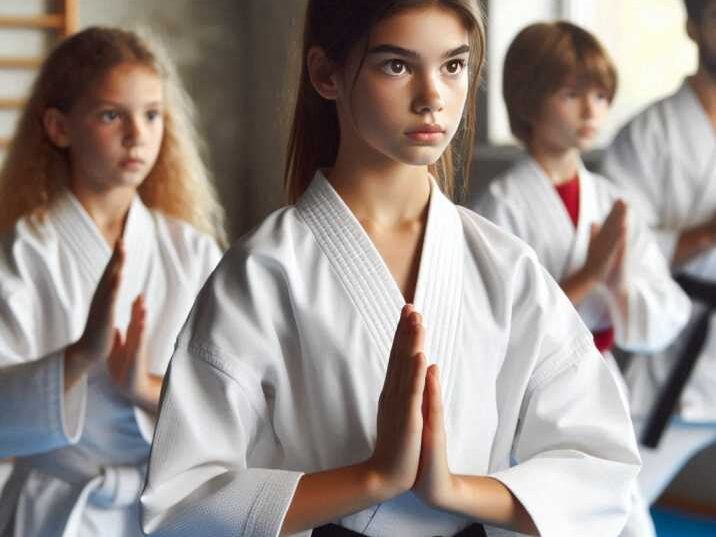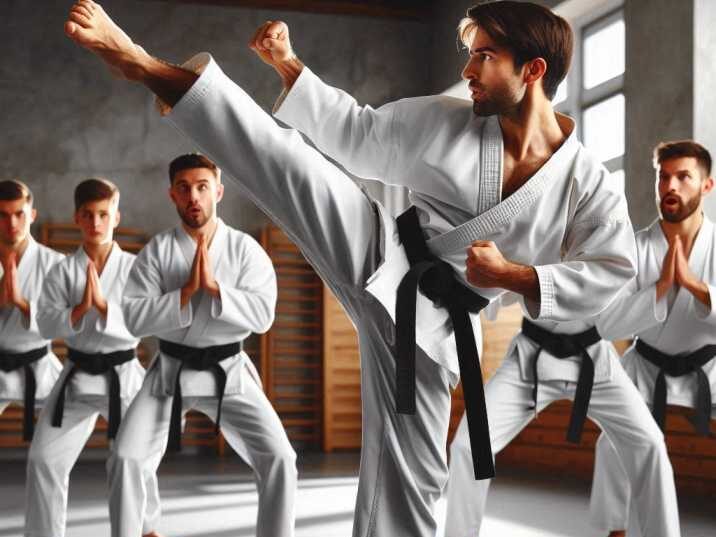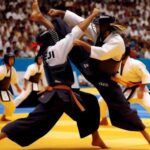Introduction
Table of Contents
Karate is a martial art that has been practiced for centuries. It’s a form of self-defense that uses punches, kicks, and blocks to protect oneself from danger. However, some people wonder if karate is really useful today. With modern self-defense techniques and other martial arts becoming popular, is karate useless? This article will explore why karate is still important, especially for kids and teens, and how it helps in many aspects of life, from school to personal growth.

1. What is Karate?
Karate is a traditional martial art that originated in Okinawa, Japan, a place known for its rich martial arts history. The word “karate” translates to “empty hand,” indicating that this martial art relies on the body rather than weapons for self-defense. Karate involves using the hands and feet to deliver powerful strikes, such as punches and kicks, and to perform defensive maneuvers like blocks. It is much more than just a fighting technique; karate is also a practice that teaches discipline, respect, and self-control, making it beneficial for both physical and mental development.
The Basics of Karate Movements
Karate is composed of various movements and techniques that are grouped into three main categories:
- Kihon (Basics): Kihon refers to the basic techniques of karate, which are the foundation of all advanced skills. These include fundamental movements like punches (tsuki), kicks (geri), and blocks (uke). Practicing kihon helps students develop muscle memory, strength, and coordination, which are essential for mastering more complex techniques.
- Kata (Forms): Kata are choreographed sequences of movements that simulate defensive and offensive techniques against imaginary opponents. Each kata consists of a specific pattern that requires precision, balance, and rhythm. Practicing kata allows karate students to perfect their techniques, improve their focus, and understand the flow of combat.
- Kumite (Sparring): Kumite involves practice fighting with a partner to apply the techniques learned in kihon and kata. It can range from light-contact sparring to more intense, full-contact fighting. Kumite helps students develop timing, reflexes, and the ability to read an opponent’s movements, making it a crucial part of learning how to apply karate in real-life situations.
2. Benefits of Karate Training
Many people might think karate is not useful because it’s not always about fighting or being aggressive. However, karate offers a wide range of benefits that go beyond physical skills. It is a holistic practice that enhances both the body and mind.
Physical Fitness and Health
Karate training is an excellent way to improve overall health and fitness. The practice involves a lot of physical activity that helps to:
- Strengthen muscles: Karate techniques require the use of different muscle groups, which helps in building muscle strength and endurance.
- Increase flexibility: Regular stretching and dynamic movements improve flexibility, which is essential for performing high kicks and agile footwork.
- Boost cardiovascular health: Karate includes high-intensity drills and sparring sessions that improve heart health and stamina. This cardio workout is beneficial for maintaining a healthy weight and reducing the risk of obesity and related health conditions.
By keeping the body active, karate training also helps children stay fit and develop healthy habits that can last a lifetime.
Mental Benefits of Karate
In addition to physical health, karate training also provides significant mental benefits. The practice of karate requires intense focus and concentration. Students must pay close attention to their movements, techniques, and surroundings during training. This mental discipline helps improve concentration in school and other activities. For example, children who practice karate often find it easier to focus on their studies or stay attentive in the classroom.
Karate also teaches perseverance. Learning new techniques or mastering a kata can be challenging, and students must practice repeatedly to get it right. This process helps them develop a “never give up” attitude, teaching them to overcome obstacles and stay committed to their goals, whether in martial arts or life.
3. Karate and Self-Defense Skills
One of the primary reasons people learn karate is for self-defense. Karate equips students with practical self-defense skills that can be used in real-life situations. The training teaches how to protect oneself if confronted by an attacker, providing both physical techniques and the confidence needed to handle such situations.
Real-Life Applications of Karate Skills
While the moves learned in karate might not always look as flashy as those seen in movies, they are very practical. Techniques like blocking an attack or delivering a quick, decisive counter-strike are highly effective for self-defense. For example, a simple block can deflect an incoming punch or kick, while a well-timed strike can disable an opponent, allowing the defender to escape safely.
Karate training also emphasizes awareness and quick reflexes, which are crucial in avoiding dangerous situations altogether. Learning how to read an opponent’s body language and anticipate their next move can make all the difference in preventing or defusing a conflict.
4. Discipline and Character Building
Karate training is not just about physical skills; it is also about building character. It instills values such as respect, humility, and integrity in its practitioners. In karate classes, students are taught to bow to their instructors and training partners as a sign of respect. This practice is more than just a ritual; it teaches humility and good manners, which are valuable in all areas of life, not just in martial arts.
The Role of Discipline in Karate Training
Discipline is a core aspect of karate training. Students are expected to practice regularly to improve their skills, which requires dedication and a strong work ethic. This discipline extends beyond the dojo (training hall) and can positively impact other areas of a student’s life. For example, the focus and determination required to perfect a karate move can also help a student stay committed to doing their homework or practicing a musical instrument.
Karate also teaches students to set goals and work steadily towards achieving them. Whether it’s mastering a new kata or earning a higher belt rank, these goals require consistent effort and patience. The lessons of perseverance and self-discipline learned in karate can help students face challenges in life with a positive attitude, understanding that hard work and persistence are the keys to success.
5. Misconceptions About Karate
There are many misconceptions about karate, such as it is not effective or outdated. However, these ideas are not true. Karate has evolved and adapted to modern needs while maintaining its traditional roots.

Karate vs. Other Martial Arts
While other martial arts like Brazilian Jiu-Jitsu or Muay Thai focus on different techniques, karate remains unique. It focuses on striking and movement, which are essential for self-defense. Comparing different martial arts is like comparing different sports; each has its own strengths and benefits.
6. Karate in Modern Times
Despite the rise of mixed martial arts (MMA) and other fighting styles, karate is still relevant today. Many MMA fighters use karate techniques in their training because of its effectiveness in striking and defense.
Karate in Popular Culture
Karate has influenced many movies, TV shows, and video games. This cultural presence helps keep karate popular among young people, who may be inspired to learn after seeing their favorite characters practice karate.
7. Karate for Kids: Why It’s a Great Choice
Karate is an excellent activity for kids because it combines physical exercise with mental discipline. It provides a structured environment where kids can learn self-defense, improve fitness, and develop social skills.
Building Confidence Through Karate
Karate helps build confidence in kids. As they learn and master new skills, they feel a sense of accomplishment. This boosts their self-esteem and makes them more confident in their abilities, both on and off the mat.
Table of Information
| Benefit of Karate Training | Description |
|---|---|
| Physical Fitness | Improves strength, flexibility, and cardiovascular health |
| Mental Discipline | Enhances focus, concentration, and perseverance |
| Self-Defense Skills | Teaches practical techniques for protecting oneself in dangerous situations |
| Character Building | Instills values like respect, humility, and integrity |
| Confidence Boost | Builds self-esteem and confidence through mastering skills |
| Misconceptions Corrected | Clarifies that karate is not outdated and is still effective in modern times |
| Cultural Relevance | Shows how karate remains popular in movies, TV shows, and games, keeping the practice alive for kids |
Conclusion
Is karate useless? Absolutely not! Karate offers numerous benefits that go beyond just learning how to fight. It teaches discipline, respect, and perseverance while improving physical and mental health. Karate can help kids build confidence, focus better in school, and develop valuable life skills. So, instead of asking if karate is useless, we should ask, “How can karate help us become better people?” The answer is clear: in many ways!
FAQs
- Is karate good for kids?
Yes, karate is excellent for kids as it teaches self-defense, discipline, respect, and improves physical fitness. - Can karate be used in real-life self-defense situations?
Absolutely! Karate techniques are practical and effective for real-life self-defense situations. - Does karate help with focus and concentration?
Yes, karate training requires concentration and discipline, which can improve focus in school and other activities. - Is karate only about fighting?
No, karate is more about self-control, discipline, and building character than just fighting. - Is karate still relevant today?
Yes, karate is still relevant and widely practiced around the world for its benefits beyond just self-defense.


